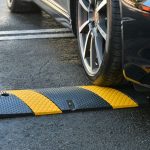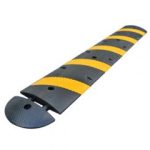Traffic control is a critical aspect of modern urban planning. With the growing number of vehicles on the road, managing traffic and ensuring safety has become a challenging task. Among various traffic calming measures, speed bumps and speed humps play a vital role in reducing vehicular speeds, preventing accidents, and improving road safety. This article provides a comprehensive comparison of speed bumps and speed humps, focusing on their characteristics, applications, advantages, and disadvantages.
What are Speed Bumps and Speed Humps?
Speed Bumps
Speed bumps are common traffic control features designed to slow vehicles to a crawl. They are usually installed in residential areas, parking lots, and near schools where pedestrians are more likely to be present. Speed bumps are typically 3 to 6 inches high and a foot or so in width, forcing drivers to slow down to around 5 to 10 mph to cross without damaging their vehicles.
Speed Humps
Contrarily, speed humps are more forgiving and intended to slow traffic to a safe speed without causing undue discomfort to drivers. Unlike speed bumps, they are not as high and are longer, typically ranging from 12 to 14 feet in length. Speed humps can be driven over at a speed of 15 to 20 mph, slowing down traffic without bringing it to a near halt.
Understanding the Applications
Residential Areas and Schools
In residential neighborhoods and near schools, speed humps are often preferred over speed bumps. Their gentle design allows for a smoother transition and reduces the impact on the vehicle. This is particularly beneficial near schools, where the constant flow of traffic necessitates a balance between safety and maintaining a steady flow of vehicles.
Parking Lots and Private Drives
Speed bumps are more commonly found in parking lots and private drives, where a more aggressive slowing of traffic is needed. The abrupt nature of speed bumps ensures that drivers maintain very low speeds, which is crucial in areas with heavy pedestrian traffic or where vehicle paths intersect frequently.
Advantages and Disadvantages
Advantages of Speed Humps
- Smooth Transition: Their longer and gentle design allows vehicles to pass over them without the jarring impact experienced with speed bumps.
- Improved Traffic Flow: Speed humps slow traffic without causing bottlenecks, ensuring a more consistent flow.
- Increased Safety: By slowing vehicles to a safe but reasonable speed, speed humps reduce the risk of accidents without overly inconveniencing drivers.
Disadvantages of Speed Humps
- Less Effective in Some Scenarios: In areas where extremely low speeds are required, speed humps may not be aggressive enough to ensure safety.
- Potential Confusion: The similarity in appearance to speed bumps may lead to confusion among drivers, potentially leading to either excessive slowing or failure to slow down adequately.
Advantages of Speed Bumps
- Highly Effective: Speed bumps force drivers to slow down significantly, making them very effective in ensuring pedestrian safety.
- Diverse Applications: They can be used in a variety of locations, from residential areas to commercial parking lots.
Disadvantages of Speed Bumps
- Discomfort and Damage: The abrupt nature of speed bumps can cause discomfort to passengers and damage to vehicles if not traversed carefully.
- Potential Traffic Congestion: By forcing vehicles to a near stop, speed bumps can lead to bottlenecks and congestion, especially during peak hours.
Conclusion
Both speed bumps and speed humps have their unique roles in modern traffic management. While speed bumps are aggressive and ensure that vehicles travel at very low speeds, speed humps offer a more forgiving approach, allowing a balance between safety and traffic flow.
Understanding the specific requirements of a location is key to choosing between speed bumps and speed humps. Urban planners and traffic engineers must consider factors such as pedestrian safety, traffic volume, and the desired flow of traffic to implement the most appropriate solution.
In the ever-evolving landscape of urban development, innovative and context-specific approaches like these will continue to play a crucial role in enhancing road safety and improving the overall quality of life for residents and visitors alike.




